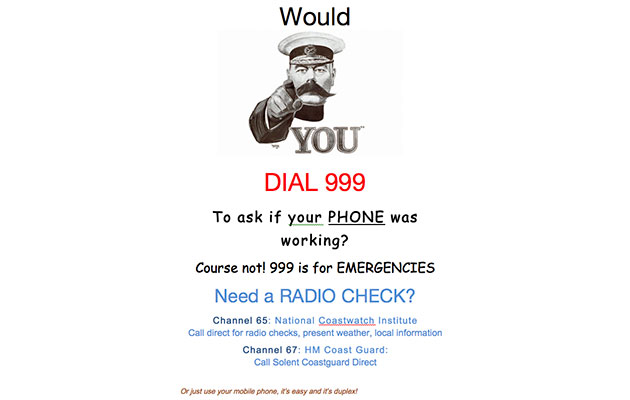As another day’s sailing begins with radio checks on Ch16, Andy Du Port says enough is enough
Enough with the radio checks already! Over!

Andy Du Port is a former RYA Cruising Instructor and Reeds Almanac editor. He sails with wife Kate on their Hallberg-Rassy 34
If you sail in any of the popular cruising areas you will be aware of the almost constant stream of radio checks with the local Coastguard. Not only is this annoying for those of us who are out on the water seeking a bit of peace and quiet, it is also an abuse of VHF Ch16, which is designated for ‘distress, safety and calling’. This means that urgent traffic may have trouble getting through and, without wishing to be over dramatic, lives could be put at risk.
Channel blocking
Earlier this summer Solent Coastguard was having a particularly busy day dealing with safety-related incidents in their large sea area (now from the River Exe in the West to Beachy Head in the East) but were relentlessly interrupted by yachts requesting radio checks. More than once I overheard the Coastguard saying to a yacht in difficulty, ‘Say again, you were over-spoken.’ He eventually managed to pass his message, but the radio checks continued.

Checking your VHF on Ch16 risks obstructing a genuine distress call. If you must check it, there are other ways
So, how often do you need to check your radio, and how can it best be done without compromising safety? A modern marine VHF radio is remarkably reliable. If it has a steady power supply, a suitable aerial, and all the associated cables and connections are sound, there is no reason to suppose it won’t work when required. If it is receiving normally, you can be confident that the aerial run is OK. Of course, like any electronic device, the internal circuitry of a VHF radio can fail, but this is as rare as it is unpredictable. In other words, just because the radio transmits during a radio check, there is no guarantee that it will work correctly the next time you try to use it.
The RYA’s VHF Handbook (G31) states: ‘Modern radios are generally reliable and seldom fail for no reason, so simply using the radio as an everyday tool is a good check that it is working.’ This is excellent advice that is followed by the various RYA Training Centres I have consulted. One told me that students on their VHF SRC courses are recommended to conduct a radio check at the beginning of the season and before a long passage. All of them discouraged the use of Ch16. If you have just installed a new radio, or have some other irrefutable reason, how should you test it?
Safer test options
First, use a channel designated for ship-to-ship or ship-to-shore working, as appropriate. If you are not sure, check in Reeds or on the Ofcom website. Ideally, send a routine DSC call to a chum. Both sets will automatically tune to the selected working channel on which you can check the radios. DSC is rarely used for non-safety traffic, but it is dead simple and prevents cluttering up Ch16; give it a go! Alternatively, agree to conduct the check with another yacht directly on a pre-arranged channel. Failing that, call a marina on Ch80 or your local National Coastwatch Institution station on Ch65 (check manning times on the NCI website or in Reeds). You could even call your own handheld VHF set. Only if you really have no alternative, call the Coastguard. In the Solent area call directly on Ch67, not Ch16.
A final plea: always follow the recommended voice procedures you were taught on your SRC Course, and never end a call with ‘Over and out,’ which means: ‘You talk, I’m not listening!’




